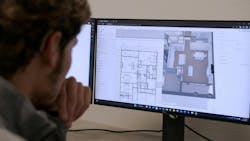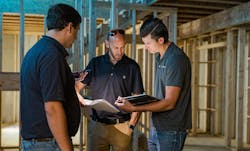An Intelligent Homebuilding Platform Unleashes the Power of Data
Marc Minor was building houses on 50 acres of North Carolina land when he came to a realization. Minor, who’d briefly attended Harvard’s School of Design before working for a 3D printing startup, recognized that homebuilding would benefit from an idea that’s big in additive manufacturing: the digital thread. It’s the concept that there should be a single, seamless flow of data about a product from design to production and sale.
“That concept so obviously would benefit homebuilding, and I constantly wished I had tools I could use when I was building houses, so I started a company to address it,” Minor says.
That company, Higharc, launched in 2018. Higharc’s intelligent homebuilding platform serves as a single source of truth for all the data that goes into designing, building, and selling homes.
“The core idea behind the business is that design should be data that is leveraged by the rest of the value chain,” says Minor, cofounder and CEO.
Homebuilding Data Analytics
Higharc automates the flow of information about home plans among the various homebuilding departments and stakeholders—from permitting officers to tradespeople to salespeople. Purchasing teams, for instance, can use the designs to generate estimates, so they can bid out jobs more quickly and effectively. With Higharc, homebuilding stakeholders, who historically have been disconnected, are always working with the same, up-to-date data and documents.
“So the builder’s team is less like independent units that have to ask for things from each other, and more like a single team moving in one direction with the same set of information,” Minor says.
With other computer-aided design (CAD) software, Minor says, the design tool is a siloed product used mostly by architects. “We unlock the power of the data inside those design documents for users outside the design department,” he says.
That power extends beyond the builder’s team to include homebuyers. Higharc can create 3D designs for sales and marketing, so that buyers see their own specific home before they buy it.
RELATED:
- Epic Games' Foray Into the Housing, Real Estate Industries
- First Virtual Tool for the Real Estate Metaverse
Higharc also addresses what Minor calls one of the biggest problems for homebuilders: changes, such as mistakes made in the field. “Changes are a complete chaos monkey for every builder,” he says. Because Higharc is Web based, any information about a home, and any change made to it, gets distributed to every platform user—eliminating the chaos. “So builders can manage change more effectively not just on a lot basis but on a community and regional basis,” Minor says.
More than enabling home design, the Higharc platform establishes patterns of design. Those patterns could involve electricity, plumbing, layouts—anything that production builders repeat from house to house. A new home design can inherit pattern rules and map them onto its floorplan. As a result, production builders can offer and manage options more easily and quickly. “It’s a powerful principle that has made an enormous difference in industries like software and manufacturing, where you repeat the same patterns to improve speed,” Minor says.
Typically, Minor says, Higharc gets contracts to close 25% faster, and it reduces plan-related variances, or mistakes made on sites due to plans, by 50%. One production builder used Higharc to get their design phase down from 120 days to just 30 days.
Though still in its early years, Higharc already boasts several seasoned investors. In July, the startup announced an investment from Carl Bass, former president and CEO of Autodesk, who also joined Higharc as an advisor; Home Depot Ventures, the home-improvement retailer’s venture capital fund; and Standard Investments, the investment arm of Standard Industries, which owns companies such as GAF, North America’s largest roofing manufacturer. With this investment, Higharc’s total capital raised now tops $40 million.


